
It’s so strange that Dario Argento’s 1996 movie called The Stendhal Syndrome is really about post-traumatic stress disorder when nearly all of his classics somehow involve Stendhal syndrome. Characters are haunted by the things they’ve seen, transformed by art that confronts them, and assaulted by it, sometimes literally. Vision is obscured either physically or by memory. Secrets are buried, covered up, painted over, walled away to fester and rot in the dark. The image of a barely reflected face obscured (by a theater bathroom scuffed beyond recognition, a fogged-up black tile, a corpse prone on a marble table, a face in a pool of blood) occurs over and over again in Deep Red.
The specters that appear as motifs across Argento’s work include beauty, science, memory, the occult, fine art (plots revolve around paintings and sculpture; he reproduces paintings as full moving compositions), classical music (frequently Giuseppe Verdi), eyes, misogyny counterbalanced by an obsession with women finally given agency, the unreliability of memory, insanity, prog rock, cursed architecture, burning buildings, defenestration, a fetishistic approach to murder, totemic objects, disturbed children (and items/places that recall childhood like dolls, schools, etc.), homosexuality (or “deviant sexuality” in an earlier era), uncaring or incompetent police, irrational urges that lead to the solution of mysteries (his films feel most like dreams in these moments), random and horrific violence that exists outside of human actions. Finally, Argento’s movies are a fealty to the works of Edgar Allan Poe, Alfred Hitchcock, Michelangelo Antonioni, and Federico Fellini (Deep Red was co-scripted with Fellini’s late-career writing collaborator Bernardino Zapponi). The film’s first killing, in the psychic’s apartment full of disturbing paintings, is paced and framed exactly like the farmhouse scene in The Birds. Every trope is explored and expanded on—this is the definitive giallo as essayed by its patron saint.
The plot of Deep Red is a direct riff on Antonioni’s Blow-Up (a film that had more influence on “Hitchcock as Genre” than Hitchcock himself did). The casting of David Hemmings as pianist Marcus Daly is deliberate, and his uncertainty about what he has witnessed at the scene of a brutal murder—a painting in a hallway he swears has been moved—is a twist on Antonioni’s ennui-filled masterpiece. Argento is not an existentialist, though, he’s a Jungian. Argento’s Rome is truly modern but built on a foundation of ghosts—the psychological is always twinned with the inexplicable (as is often the case in his work, the most fantastic and mystical pair with concrete details of the fascistic and ugly).
Argento made Deep Red as a response to his first big failure, the director’s 1973 attempt at political comedy, The Five Days. He needed a hit, so he went as hard as possible in the genre he helped formalize. Argento had popularized the giallo genre with The Bird with the Crystal Plumage (1970), which made so much money that Italy had a gialli boom, and he revived the career of his predecessor Mario Bava. One of the most exciting things about Deep Red is that it’s both a bizarre, dreamlike art film and blockbuster entertainment. The ornate and confusing deaths, the killer in black gloves, a civilian thrust into the position of the detective (critic Mikel J. Koven said that gialli have the most in common with the flaneur novels and Agatha Christie; middle- and upper-class people idly dealing with extreme violence and death).

The killer plays a tape of a children’s choir before committing many of the murders. Childhood is always poisoned in some way: the little girl who shows Marcus the abandoned house is chastised for torturing lizards… the idea of a permanently ruined Christmas is perfect for something so primal. What would make someone any more of a nervous wreck than a murder on Christmas? Or, in the dated parlance of Deep Red, what could make someone into an insane person, a drunk, or a homosexual (all of whom the killer in Tenebrae would call a deviant)?
The American edit of the film (currently the only one available on streaming services) cuts out many of the scenes between Marcus and Gianna (Daria Nicolodi) that play as a romantic comedy of the sexes to counterpoint the intensity of the film’s ending. It also seems to cut out any implication that Gianna could be the murderer, neutering the most beautiful sequence, in which she sits over Marcus as he awakes to a burning mansion, and she tenderly speaks to him in lush profile shots. The lingering meet of her gaze with the camera accents her black eyeliner, which so far has been associated with the killer.
The poor mental state of Marcus’s best friend Carlo (Gabriele Lavia) is first attributed to alcoholism due to his being in the closet (Carlo is sleeping with a fey twink in his mother’s house), but is finally traced back to his childhood trauma—the film’s central image is a small boy lifting a bloodstained knife in front of a Christmas tree. Later, we see a depiction of the event as a covered-up mural in an abandoned house. We are shown evidence of Carlo’s tortured psyche, but not given its resolution until after he is randomly and brutally dragged to death by a garbage truck then beheaded by a truck tire. The movie escalates to the final beheading of the killer, where the methods of death from the first killing have all been built toward a beheading (always assaults to the head and neck), we as an audience subconsciously expect it.
Argento’s films are often sideways confessions. The true villain of Deep Red is an elderly former actress who’s slipping into insanity—one that we can now read as an indictment of Argento’s possibly abusive actress mother. Guillermo del Toro once said if Argento is anyone in his work, he’s both the killer and the little boy witnessing the murder, raising the gleaming, blood-slick knife to his face. There is something childish in the way Argento conceives of people interacting, the way he portrays sexuality, and the glee he takes in making violence the most beautiful aspect of his work.
Argento’s visual mastery ensures that the dripping blood on the knife in the flashback and the dripping blood off the jagged necklace that is inexplicably caught in an elevator and squeezes her neck until her head is lopped off are the same shape. Deep Red’s camerawork is full of unsettling flourishes and finicky little inserts. Very often we are in an omniscient perspective, then the killer’s, then ominously microscopic. The only perspective we are ever sure of is the killer’s.
The reveal in the film that is most telling is not the explanation of the mystery or the reveal of the killer. It is that what Marcus first saw as art was nothing but a mirror…

is a writer and filmmaker living in Brooklyn.
Mario Bava was a living embodiment of Italian genre cinema, working credited and uncredited on nearly a hundred films. He was a cinematographer, a special-effects artist...
BY LAURA WYNNE | April 5, 2024
Timothy Leary taught us that set and setting are critical to determining the shape of any mind-altering experience. Mindset: sleep-deprived after an unfortunate all-nighter...
BY TOM PHELAN | November 5, 2025
Like the best fairy tales, which often portray darkness through the lens of childhood innocence, Laurín tells a dreamily surreal story of hardened youth.
BY LAURA KERN | March 17, 2022

This pre-Code offering packs a lot of story into its typically brisk running time, with several plot threads weaving together a (not always successful) tapestry of spooky and criminal doings.
READ MORE >
BY ANN OLSSON | Month 00, 2021

In what could be the fastest-resulting rape revenge movie, a drunken lout brutally forces himself on Ida, the young woman who doesn't return his affections, during a party over Labor Day.
READ MORE >
BY LAURA KERN | Month 00, 2021

Beast is a lot of movies in one package - fractured fairy tale, belated-coming-of-age story, psychological drama, regional horror film - but above all it's a calling card for its leading lady, Jessie Buckley.
READ MORE >
BY LAURA KERN | Month 00, 2021